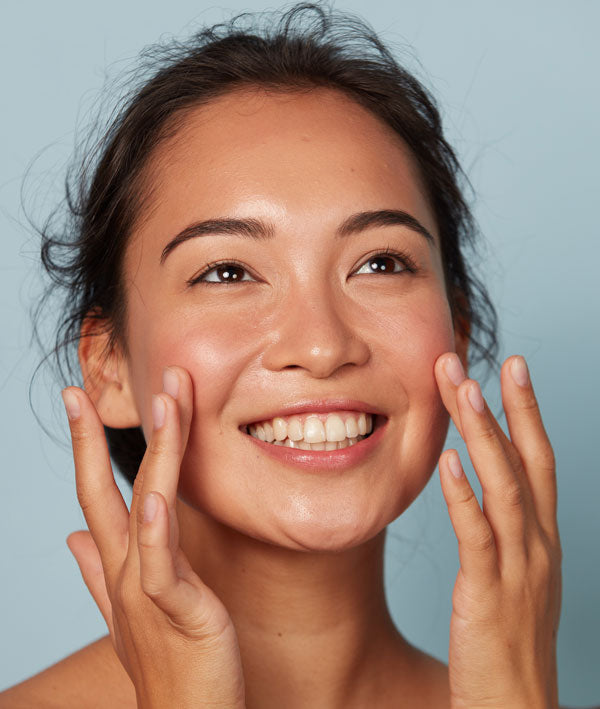Hyperpigmentation is one of the most prominent skin concerns – but it’s also one of the issues that many people have the most trouble treating. In this guide, we’ll go over our five tips for fading hyperpigmentation to achieve a clear, even skin tone.
What is Hyperpigmentation?
Hyperpigmentation is a general term used to describe dark spots or discoloration in the skin. This discoloration in the skin forms when a specific trigger causes the body to produce extra melanin, which is responsible for skin pigment. These spots can range in color, often looking light or dark brown, red or pink, or gray.
Hyperpigmentation falls under three main categories. The first is sun spots (also known as age spots), which are caused by chronic exposure to UV rays. There is also post-inflammatory hyperpigmentation, which is triggered by an injury to the skin (most often acne). Finally, there is melasma, which is caused by hormonal fluctuations (typically those related to pregnancy).
Treating Hyperpigmentation
Thankfully, hyperpigmentation isn’t harmful. That said, many choose to seek out treatments to fade their appearance for a more even skin tone. Here are the most effective solutions for treating hyperpigmentation.
1. Sun Protection
No matter the type of hyperpigmentation you are dealing with, sun protection is a non-negotiable in your treatment plan. If you implement steps to fade hyperpigmentationwithouthaving a proper sunscreen regimen in place, you’re just going to find yourself back at square one.
Sunscreen (and other methods of shielding your skin from the sun) will help prevent discoloration from forming in the first place, ensuring you don’t have to fade more dark spots in the future. UV rays can also darken existing spots, which will just hinder your treatment progress. To achieveandmaintain an even skin tone, wearing sunscreen on a daily basis (and reapplying when needed) is an absolute must.
2. Serums
Anyone looking to fade hyperpigmentation should also incorporate serums into their daily routine. By far, the best over-the-counter product for treating hyperpigmentation is a vitamin C serum, such as our Vitamin C Boost Serum.
Vitamin C is a powerful skin brightener that has been shown to fade dark spots, promoting a more even skin tone. It’s also a potent antioxidant that defends against free radical damage – which can contribute to discoloration. This means that, by using a vitamin C serum regularly, you can not only fade current dark marks, but also prevent future marks from forming.
3. Chemical Peels
For those with more aggressive dark spots, chemical peels are a great option. While there are over-the-counter chemical peels, for the best (and safest) results, we recommend seeking out a treatment from a dermatologist.
There are varying levels of chemical peels. With a light chemical peel, a potent mixture of chemical exfoliants (like glycolic, lactic, and mandelic acids) is used to remove the top layer of the skin (the epidermis) to reveal fresher, more even toned skin.
Light peels are often suitable for treating hyperpigmentation, but a dermatologist may decide that a medium chemical peel is best for your skin’s needs. With this stronger peel, the solution removes the epidermis, as well as skin cells from the top of the middle layer of your skin (the dermis).
4. Laser Therapy
Another in-office treatment that’s great for addressing discoloration is laser therapy. With this type of therapy, targeted laser beams tackle melanin to promote a more even skin tone.
There are two forms of laser therapy. Ablative is more aggressive, and while effective, it does require some downtime post-treatment. Non-ablative (which includes intense pulsed-light therapy, or IPL) is gentler on the skin and doesn’t require any downtime. That said, it doesn’t offer the most dramatic results – although it may still be enough for those with less prominent hyperpigmentation. A dermatologist will determine which is best for you.
5. Microneedling
Over the past few years, microneedling has become a popular in-office treatment. With this minimally invasive procedure, super thin needles are used to puncture the skin. This triggers the body’s natural healing process, leading the skin to produce collagen and elastin. This helps promote smoother, more even toned skin.
What’s also great about microneedling is that there isn’t any downtime required. That said, the skin may be red and swollen for a couple days after the treatment.
Importance of Patience and Consistency
As a final note, it’s important to emphasize that no solution is going to lead to immediate results. In the case of at-home topical solutions, it will take weeks before you start seeing your dark spots fade. On the other hand, with in-office treatments, in most cases you’ll need more than one session to fully diminish discoloration.
Remember to be patient with yourself and your skin, and to stay consistent with your routine. Soon enough, you’ll be on the other end of your treatment plan with a clear, radiant complexion!






